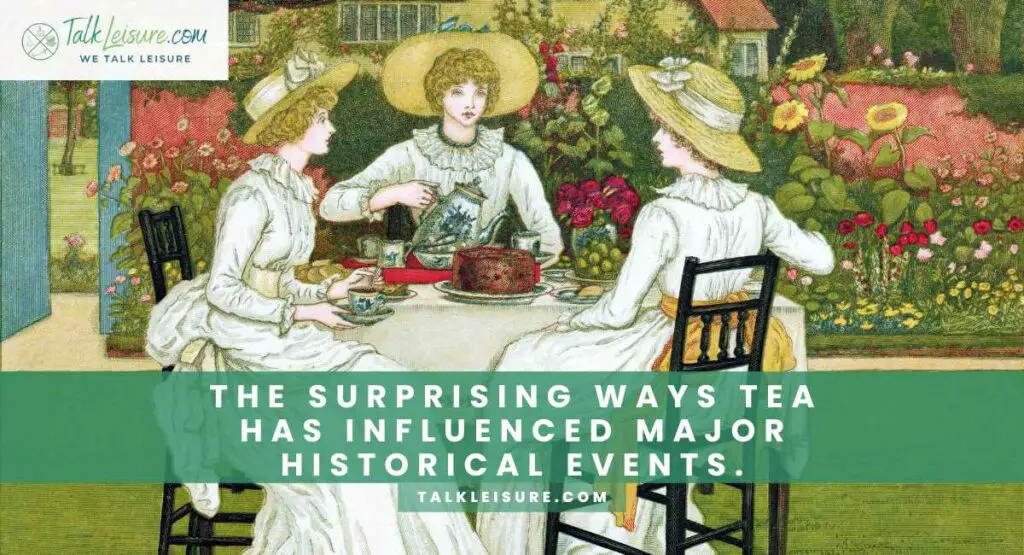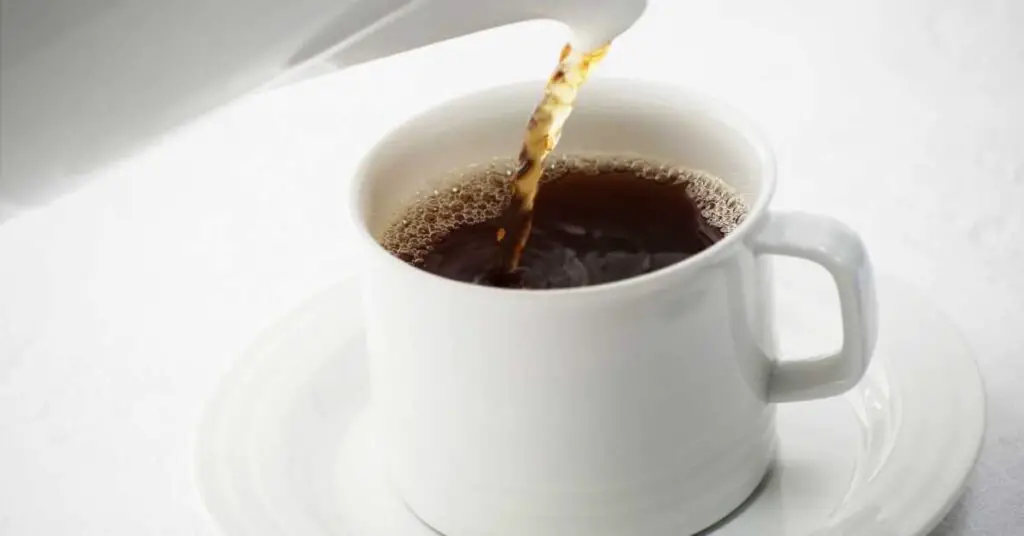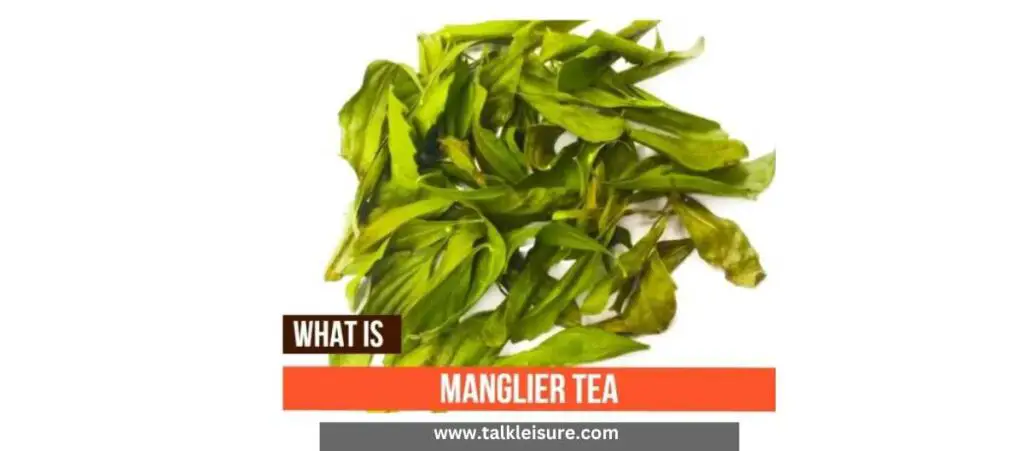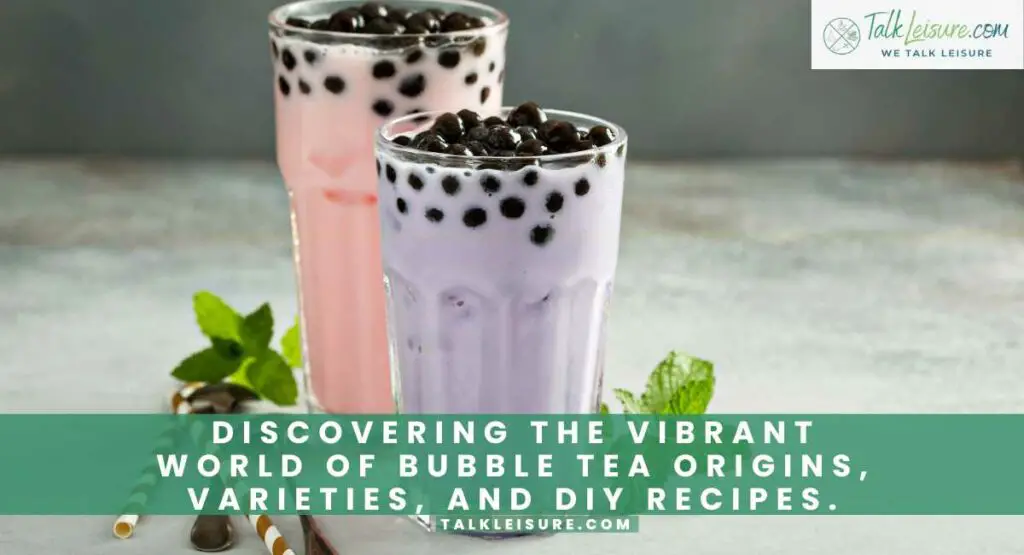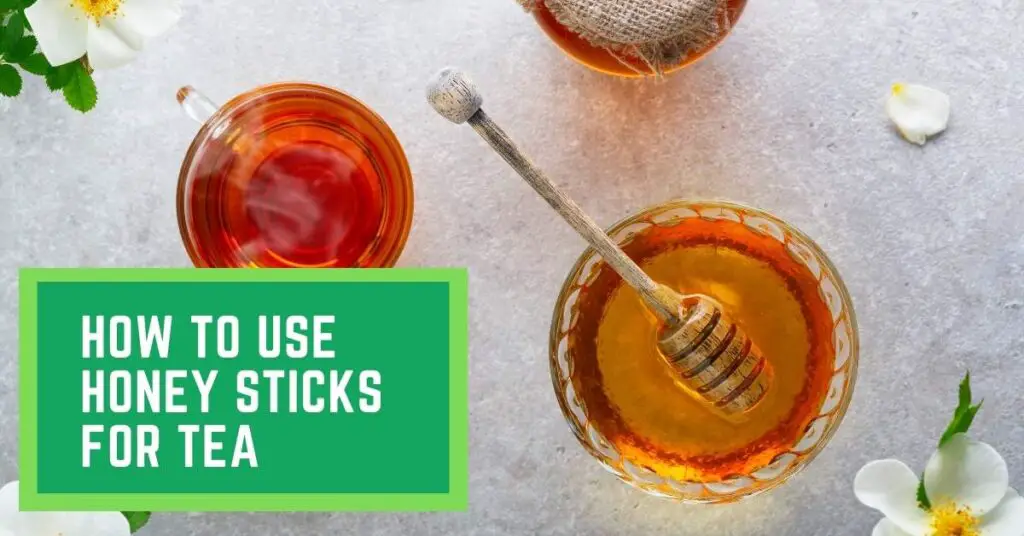Embark on a journey into the world of tea, where every sip tells a story of sustainability, ethical sourcing, and the delicate dance between nature and culture.
Sustainable and ethical tea sourcing and consumption involve practices that prioritize environmental stewardship, fair labor conditions, and social responsibility throughout the tea production process. It is a commitment to minimizing ecological impact and promoting positive social and economic contributions within the tea industry.
In this exploration, we delve into the very essence of your daily ritual, uncovering the environmental impact of tea production, deciphering labels that guide ethical choices, and embracing packaging solutions that honor our planet.
From the misty hills of Darjeeling to the innovative packaging realms, join us as we sip our way through the rich tapestry of global tea cultures, committed to a future where each infusion reflects a conscious choice for a more sustainable and ethical world.
Also read: A deep dive into the flavors, aromas, and textures of white, green, black, and oolong teas.
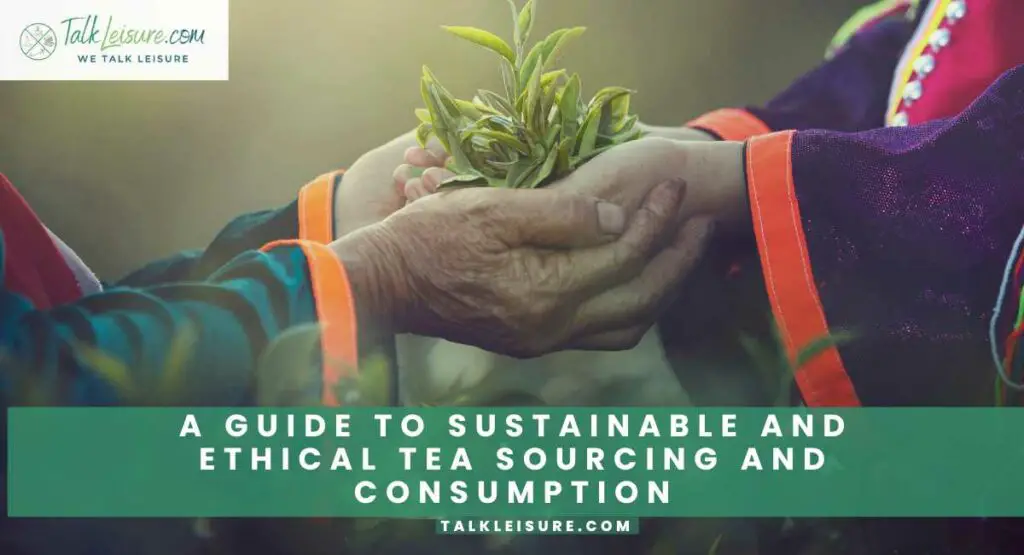
Introduction to Sustainable Tea
Defining Sustainability in the World of Tea
Alright, tea aficionados, let’s kick off our journey by demystifying the buzzword that’s at the heart of our quest: sustainability. When we talk about sustainable tea, we’re not merely referring to a fleeting trend or a marketing gimmick; we’re delving into a commitment to the long-term health of our planet and the tea industry.
Sustainability in tea isn’t a one-size-fits-all concept. It’s a complex, multi-faceted idea that considers environmental, social, and economic factors. Picture a tea garden where the balance between soil health, biodiversity, and fair labor practices isn’t just maintained but is actively nurtured. It’s about cultivating tea leaves with a keen eye on the ecological harmony of the entire ecosystem.
In simpler terms, sustainable tea practices aim to leave the planet in a better state than we found it. From planting the seeds to steeping your favorite blend, every step is a dance with nature, a symphony of responsible choices.
Importance of Choosing Sustainable Tea
Now that we’ve scratched the surface of what sustainability means in the tea universe, let’s address the burning question: Why should you care?
Your cup of tea holds power to create ripples of change. Choosing sustainable tea isn’t just about feeling good; it’s about doing good. It’s about acknowledging that every sip you take is an endorsement of practices that respect the environment, support communities, and uphold ethical standards.
By opting for sustainable tea, you become a conscious consumer, a guardian of the earth’s resources. You send a message to the tea industry that you value transparency, ethical sourcing, and the well-being of those involved in crafting your daily ritual.
It’s a small act with far-reaching consequences, like a drop in a pond creating waves that touch every corner.
So, as we embark on this exploration of sustainable tea, keep in mind that your choice matters. It’s not just a choice for your palate; it’s a choice for the planet and the future of tea as we know it. Get ready to discover the stories steeped in every cup and the impact your tea-drinking habit can have on the world.
The journey into the world of sustainable tea has just begun. Grab your favorite mug, and let’s sip our way to a better, more sustainable future!
Also read: The world’s most expensive teas and what makes them special.
The Environmental Impact of Conventional Tea Farming
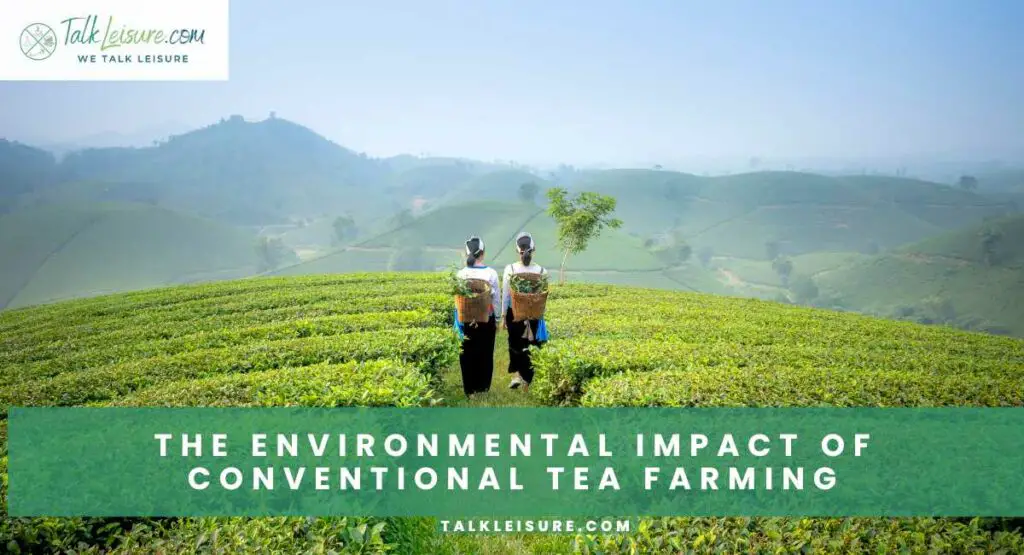
Pesticide and Chemical Use in Traditional Tea Farming
Welcome to the darker side of the tea plantation, where the lush fields often hide a not-so-fragrant secret: the pervasive use of pesticides and chemicals. As we lift the veil on conventional tea farming, you’ll discover the cocktail of substances that may be lingering in your favorite brew.
In the pursuit of pest-free tea leaves, conventional tea farms often resort to heavy pesticide use. These chemicals, designed to ward off insects and diseases, can leave a toxic residue on the leaves, which, when brewed, ends up in your teacup. It’s like inviting unwanted guests to your daily ritual—guests that go by names you can’t pronounce.
But the impact doesn’t stop at your mug. These pesticides leach into the soil, finding their way into water sources and affecting ecosystems far beyond the boundaries of the tea plantation. It’s a chain reaction with consequences that ripple through the environment, touching everything from aquatic life to the air we breathe.
Impact on Soil Health and Biodiversity
Now, let’s dig a little deeper—into the very soil that nurtures the tea plants. The continuous use of pesticides and chemical fertilizers in conventional tea farming takes a toll on the soil, disrupting its natural balance and fertility.
Imagine soil stripped of its vitality, its rich biodiversity reduced to a monoculture. Conventional tea farms, aiming for high yields, often sacrifice the diverse ecosystem that healthy soil supports. The intricate web of microorganisms, insects, and plants that make up a thriving soil community is disrupted, leading to a loss in fertility and resilience.
But that’s not all. Biodiversity, a key player in a balanced ecosystem, takes a hit. Monoculture tea plantations become ecological deserts, devoid of the diversity that provides natural checks and balances against pests and diseases. It’s a recipe for disaster, with far-reaching consequences for the sustainability of tea farming and the delicate ecosystems it inhabits.
As we continue our exploration, keep in mind the hidden costs behind that seemingly innocent teabag. The choice between conventional and sustainable tea goes beyond taste—it’s a choice for the health of our planet and the intricate dance of life within every tea plantation.
Ready for the next revelation on our journey to sustainable sipping? Grab your mug; we’re just getting started.
What constitutes ethical tea production?
Ethical tea production encompasses practices that prioritize social, environmental, and economic responsibility throughout the entire tea cultivation and manufacturing process. This approach emphasizes fair treatment of workers, sustainable farming methods, and a commitment to preserving biodiversity and ecosystems.
In essence, ethical tea production seeks to minimize negative impacts on both people and the planet while promoting transparency and responsible sourcing within the tea industry.
Certifications and Labels
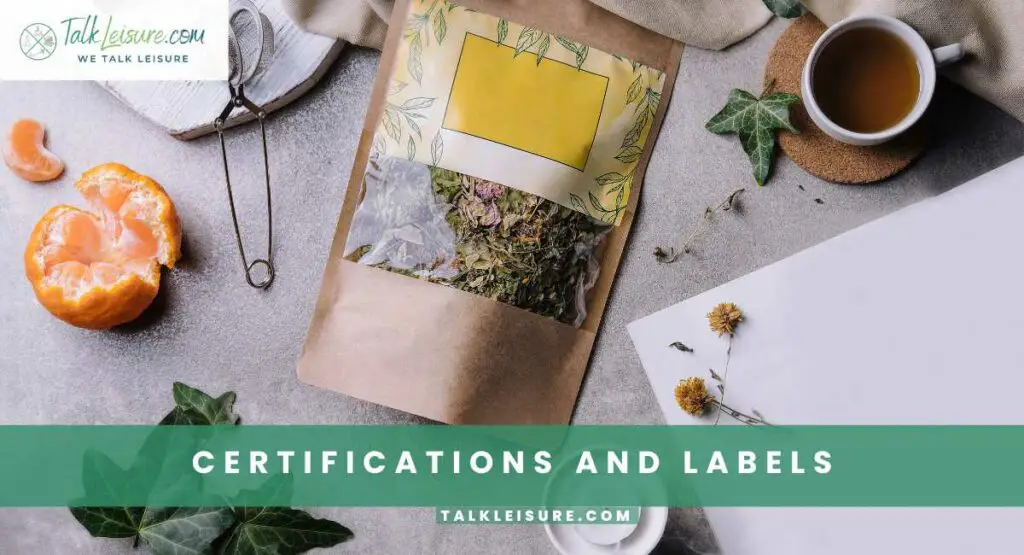
Understanding Organic, Fair Trade, and Rainforest Alliance Certifications
Tea shelves can be a labyrinth of labels, each promising a unique flavor or experience. But beyond the marketing allure, some labels carry a deeper significance—they speak to the ethical footprint of your tea. Let’s decode the language of certifications and unveil the stories they tell.
Organic Certification: When your tea proudly wears the “organic” badge, it means it has been cultivated without synthetic pesticides or fertilizers. Organic farming is a holistic approach that nurtures the soil, supports biodiversity, and avoids harmful chemicals. It’s like a commitment to purity, both for the earth and your teacup.
Fair Trade Certification: Picture your tea leaves as ambassadors of fairness. Fair Trade certification ensures that the farmers behind your brew receive fair wages, work in safe conditions, and benefit from community development initiatives. It’s about creating a direct link between your tea and positive social impact, empowering communities to thrive.
Rainforest Alliance Certification: If your tea boasts the green frog of the Rainforest Alliance, it signifies a commitment to environmental and social responsibility. These teas are grown in a way that protects ecosystems, supports wildlife habitats, and upholds the well-being of workers. It’s like a sip of the rainforest in your cup, where every drop tells a story of conservation.
How to Interpret Labels for Ethical Tea Sourcing
Now that you know what these certifications mean, let’s talk about decoding the labels on your favorite tea packaging. It’s time to empower you, the savvy consumer, with the tools to make informed choices.
Look Beyond the Buzzwords
Don’t be swayed by vague terms like “natural” or “pure.” Dive into the specifics. Seek out labels that explicitly mention organic or fair trade practices. These are the badges of honor that indicate a commitment to ethical sourcing.
Check for Symbols
Certifications often come with distinctive symbols. The USDA Organic seal, the Fair Trade Certified label, or the Rainforest Alliance frog—they’re like the superhero emblems of ethical tea. Spotting these symbols on your tea packaging is your shortcut to a more conscious purchase.
Explore Brand Transparency
Ethical brands are proud to share their journey. Check the brand’s website for details on their sourcing practices, partnerships, and sustainability initiatives. A brand that is transparent about its sourcing is likely to be committed to ethical standards.
Read Between the Lines
Sometimes, the story is in the details. Look for teas that specify the region of cultivation, the farming practices, and the impact on local communities. The more information, the better. It’s a sign that your tea is more than just a beverage—it’s a narrative of responsible sourcing.
As you navigate the aisles of tea options, armed with this knowledge, you become a conscious curator of your tea experience. The certifications and labels on your tea aren’t just adornments; they’re invitations to join a movement—a movement towards a more sustainable, ethical, and flavorful world of tea.
Ready to dive into the next chapter of our tea expedition? Keep that kettle warm; we’re steeping into the heart of ethical tea sourcing.
The Importance of Fair Labor Practices
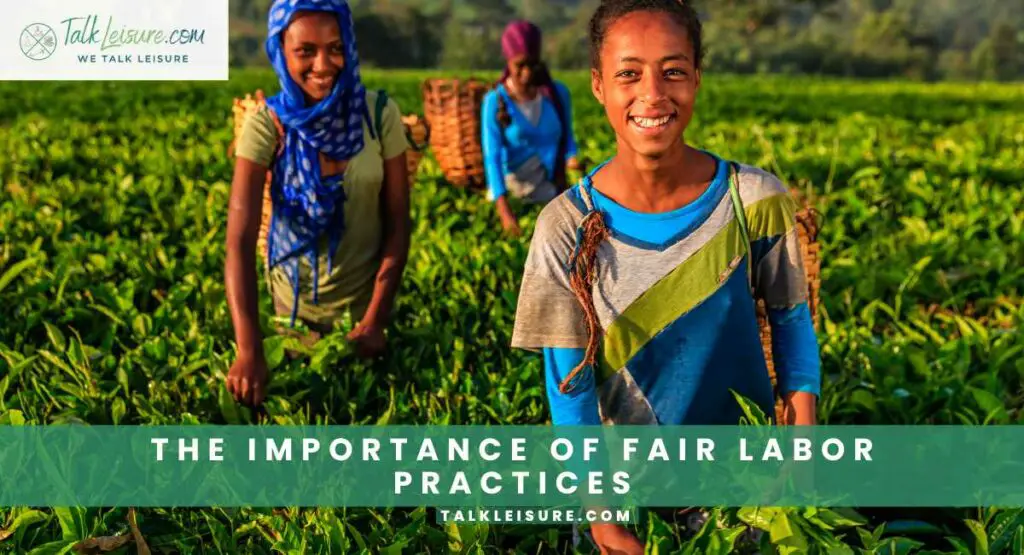
Addressing Labor Issues in the Tea Industry
In the sprawling landscapes where tea leaves unfurl under the sun, there exists a shadowed narrative often overlooked—the human story behind every cup. As we lift the curtain on the tea industry, it becomes imperative to confront the labor issues that linger in the background.
The Plight of Tea Workers
Many tea workers face challenges such as long working hours, inadequate wages, and sometimes even substandard living conditions. The demands of the industry can result in harsh working conditions, impacting the physical and mental well-being of those laboring to bring tea from the fields to our mugs.
Gender Disparities
Women, often a significant workforce on tea plantations, may face additional challenges. Unequal pay, limited opportunities for career advancement, and inadequate healthcare are prevalent issues. Unraveling the layers of gender disparities within the tea industry is a crucial step toward fostering fair and inclusive labor practices.
Child Labor Concerns
In some regions, the tea industry has faced allegations of child labor. It is essential to address and eradicate such practices, ensuring that the cultivation of tea does not compromise the well-being and education of children.
Benefits of Supporting Fair Labor Practices in Tea Production
Now, let’s explore the transformative power of supporting fair labor practices in the tea we choose to savor.
Empowering Communities
When you opt for tea produced under fair labor practices, you become a stakeholder in community empowerment. Fair wages and improved working conditions contribute to the overall well-being of tea workers and their families. It’s a direct investment in the communities that cultivate the leaves we cherish.
Social Equality and Inclusion
Fair labor practices strive to bridge the gap between different segments of the workforce, promoting equality and inclusion. This extends to addressing gender disparities, ensuring that women in the tea industry have equal opportunities, fair wages, and a supportive working environment.
Productivity and Quality
A workforce treated with dignity and respect is likely to be more motivated and engaged. By supporting fair labor practices, you indirectly contribute to a more motivated and content workforce, potentially enhancing the quality of the tea produced.
Positive Environmental Impact
Fair labor practices often go hand in hand with sustainable and environmentally conscious farming methods. By choosing tea that upholds fair labor standards, you align yourself with a holistic approach to production that considers both people and the planet.
In making the conscious choice to support tea produced with fair labor practices, you not only elevate your tea-drinking experience but also become a part of a movement that advocates for a more equitable, compassionate, and sustainable tea industry. So, as you take that next sip, remember the impact your choice holds beyond the flavor—it’s a vote for a better, more just world.
Ethical Tea Sourcing Around the World
Examining Tea-Producing Regions Committed to Ethical Practices
The journey into ethical tea sourcing takes us across the globe, weaving through regions where tea isn’t just a beverage but a tradition, a way of life. Let’s explore the corners of the world where tea is cultivated with a commitment to ethical practices.
Darjeeling, India
Nestled in the foothills of the Himalayas, Darjeeling is renowned not only for its distinctive black tea but also for its dedication to sustainable and ethical practices. Many tea estates here prioritize organic cultivation and fair labor standards, creating a blend that carries the essence of the mountains and the stories of those who nurture the tea gardens.
Yunnan, China
Yunnan province, often regarded as the birthplace of tea, embraces a rich tradition intertwined with ethical tea production. Here, tea farms are embracing sustainable farming methods, including organic cultivation and biodiversity conservation. Yunnan exemplifies a harmonious coexistence between tradition and progressive, eco-conscious practices.
Sri Lanka (Ceylon)
The emerald landscapes of Sri Lanka yield the famed Ceylon tea, and the island is making strides in ethical tea sourcing. Many estates in Sri Lanka adhere to fair trade principles, ensuring that workers receive fair wages and participate in community development initiatives. The tea from this region not only delights the palate but also tells a story of social responsibility.
Uji and Shizuoka, Japan
Japan’s tea plantations, particularly in regions like Uji and Shizuoka, exemplify a commitment to ethical practices. Renowned for their green teas, these plantations prioritize meticulous cultivation techniques, ensuring minimal environmental impact. Embracing traditions like shaded growing methods, these regions maintain a delicate balance between nature and tea production, reflecting a dedication to sustainability and quality in every tea leaf harvested.
Steps to Ensure Ethical Tea Consumption

Tips for Consumers to Make Informed Choices
Embarking on the journey of ethical tea consumption is not only a mindful choice but also a step towards shaping a more sustainable tea industry. Here are some practical tips to guide you in making informed and ethical choices as a tea enthusiast:
- Educate Yourself
Knowledge is your most potent tool. Familiarize yourself with various certifications like organic, fair trade, and Rainforest Alliance. Understand what each label signifies and how it aligns with your values.
- Read Labels
Before adding that box of tea to your shopping cart, take a moment to read the label. Look for certifications, origin information, and any details the brand provides about its sourcing practices. Transparent brands often share their commitment to ethical sourcing.
- Explore Local Options
Seek out local tea producers and artisanal blends. Not only does this support local businesses, but it also often means a smaller carbon footprint as the tea hasn’t traveled across continents to reach you.
- Diversify Your Tea Experience
Experiment with different types of tea. Diversifying your tea collection might lead you to discover hidden gems produced by smaller, ethical producers who may not have a global presence but prioritize sustainable practices.
- Ask Questions
Don’t hesitate to ask questions, whether at your local tea shop or directly from brands. Inquiring about sourcing practices, labor conditions, and environmental commitments encourages transparency and reinforces the importance of ethical standards.
Identifying Ethical Brands and Suppliers
Navigating the sea of tea brands can be overwhelming, but here are key indicators to help you identify those committed to ethical sourcing:
Certifications
Look for teas with recognized certifications such as USDA Organic, Fair Trade, or Rainforest Alliance. These symbols serve as assurances that the tea aligns with specific ethical and environmental standards.
Transparent Sourcing
Ethical brands are proud to share their sourcing journey. Check the brand’s website or packaging for information on where and how they source their tea. A commitment to transparency often indicates a dedication to ethical practices.
Social Responsibility
Brands that prioritize fair labor practices and community development often communicate these values. Explore the brand’s initiatives beyond just the product, focusing on their efforts to make a positive impact on both people and the planet.
Customer Reviews
Sometimes, the best insights come from fellow consumers. Reviews and testimonials can provide valuable information about a brand’s commitment to ethical practices and the quality of their products.
Supporting Local or Small-Batch Producers
Smaller, local, or artisanal tea producers may not always carry well-known certifications, but they could still adhere to ethical practices. Explore local markets or specialty shops to find unique teas produced with care.
By weaving these tips into your tea selection process, you not only enrich your tea-drinking experience but also contribute to a demand for ethical practices within the tea industry. Your choices have the power to shape a tea culture that is not only delightful but also sustainable and socially responsible. So, as you sip your next cup, savor the knowledge that you’re part of a movement brewing positive change.
Tea Packaging and Sustainability
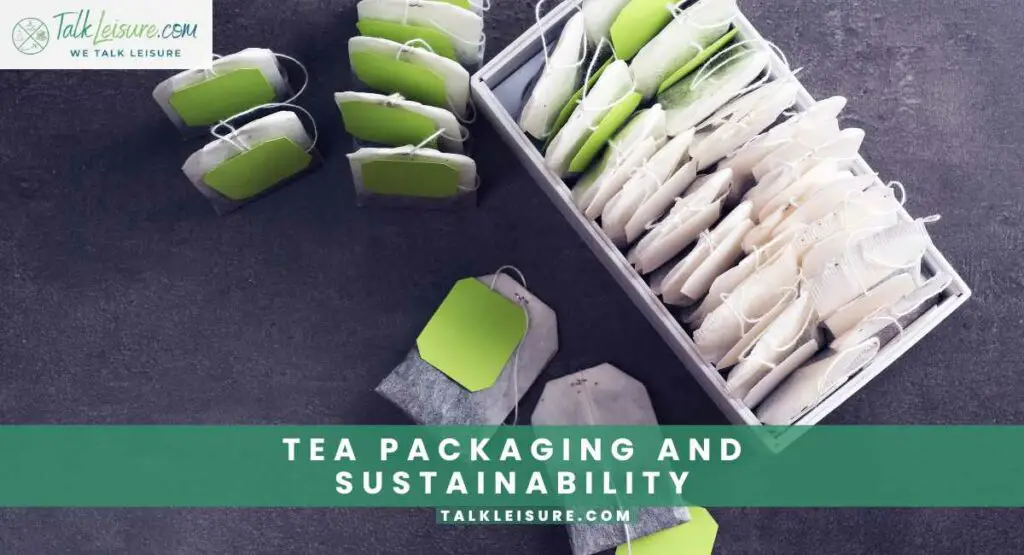
The Environmental Impact of Tea Packaging
The allure of a fragrant, steaming cup of tea often begins with the rustle of packaging. However, this seemingly innocuous aspect of our tea ritual bears a significant environmental footprint. Let’s unwrap the environmental impact of tea packaging:
Single-Use Plastics
Traditional tea packaging often relies on single-use plastics, from individually wrapped tea bags to outer packaging. These plastics contribute to the ever-growing problem of plastic pollution, impacting marine life, ecosystems, and even infiltrating our food chain.
Excessive Packaging
Some tea products come adorned with layers of packaging—boxes within boxes, foil wraps, and additional plastic. This excess packaging not only generates more waste but also consumes more resources in its production and disposal.
Carbon Emissions
The transportation of tea from production to packaging facilities and, eventually, to retailers or consumers often involves significant carbon emissions. This transportation-related carbon footprint adds to the overall environmental impact of the tea industry.
Are tea bags sustainable?
The sustainability of tea bags depends on various factors, including the materials used, the manufacturing process, and the disposal method. Here’s a breakdown:
1. Conventional Tea Bags
- Materials: Traditional tea bags often contain a mix of paper and plastic, typically made from polypropylene. The plastic is used to seal the edges and ensure the bag doesn’t disintegrate during steeping.
- Environmental Impact: The use of plastic in tea bags can contribute to plastic pollution. When disposed of in landfills, the plastic components may take a long time to break down.
- Sustainability Concerns: Conventional tea bags may raise sustainability concerns due to the reliance on non-biodegradable materials.
2. Biodegradable Tea Bags
- Materials: Some tea bags are made from biodegradable materials, such as plant-based fibers like cornstarch, PLA (polylactic acid), or hemp.
- Environmental Impact: Biodegradable tea bags break down more easily in composting conditions, reducing the long-term environmental impact compared to traditional tea bags.
- Sustainability Benefits: Choosing biodegradable tea bags can be a more sustainable option, especially if they are certified as compostable.
3. Loose Leaf Tea
- Materials: Loose leaf tea typically involves less packaging, especially if purchased in bulk or in minimal, recyclable packaging.
- Environmental Impact: Loose leaf tea generally has a lower environmental impact compared to tea bags, especially when the packaging is minimal and recyclable.
- Sustainability Benefits: By opting for loose leaf tea, consumers can reduce their contribution to packaging waste.
4. Silk or Cloth Tea Bags
- Materials: Some specialty tea bags are made from silk or cloth materials, which are often biodegradable and can be composted.
- Environmental Impact: These bags can have a lower environmental impact compared to traditional paper/plastic tea bags, especially if they are free from synthetic materials.
- Sustainability Benefits: Silk or cloth tea bags may be a more sustainable choice, but it’s essential to check the specific materials used.
5. Reusable Tea Bags
- Materials: Some tea bags are designed for multiple uses, made from durable materials like cotton or muslin.
- Environmental Impact: Reusable tea bags can significantly reduce waste over time, especially when used with loose leaf tea.
- Sustainability Benefits: Choosing reusable tea bags aligns with sustainability goals and can be a long-term, eco-friendly option.
In conclusion, the sustainability of tea bags varies, and consumers can make more informed choices by checking the materials used in the bags and their disposal properties. Opting for loose leaf tea or biodegradable tea bags can be more environmentally friendly alternatives.
Additionally, using reusable tea bags is a sustainable option for those looking to minimize waste.
Conclusion
As we reach the final steep of our journey through the world of tea, let’s savor the essence of conscious consumption. With each choice, from ethical sourcing to eco-friendly packaging, we’ve contributed to a tapestry of positive change.
Together, we’ve explored the lush landscapes of responsible tea cultivation, deciphered the language of certifications, and embraced sustainable sipping. As we set down our mugs, let’s carry forward this commitment, recognizing that the stories in our tea cups extend far beyond flavor. Here’s to a future where every brew embodies the harmony of ethical choices, leaving a lasting imprint on the world we share. Cheers to a sustainable tea journey!
Frequently Asked Questions
- How is tea eco-friendly?
Tea can be eco-friendly due to several factors. Sustainable tea cultivation methods prioritize organic practices, reducing the use of harmful chemicals. Ethical sourcing ensures fair labor conditions, contributing to social responsibility. Choosing loose-leaf tea minimizes packaging waste, and opting for biodegradable tea bags supports eco-friendly disposal. The tea industry’s commitment to environmental and social well-being makes conscientious tea consumption a sustainable and planet-friendly choice.
- What are the environmental issues with tea?
Tea production poses environmental challenges. Conventional farming often involves the use of pesticides and chemicals, leading to soil degradation and biodiversity loss. Excessive packaging, particularly in tea bags, contributes to plastic pollution. Transportation-related emissions add to the carbon footprint. Addressing these issues involves transitioning to sustainable farming, minimizing packaging waste, and embracing eco-friendly cultivation and packaging practices.
- What are the economic factors affecting tea?
Economic factors significantly impact the tea industry. Fluctuations in global demand and supply can influence tea prices. Labor costs, especially in regions where tea is hand-plucked, contribute to production expenses. Currency exchange rates and international trade policies further shape the economic landscape. Additionally, factors like climate change and natural disasters can affect tea yields, impacting the overall economic viability of tea production in different regions.




